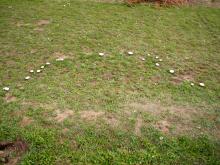Cause Nearly 60 different species of basidomycete fungi have been implicated in fairy rings including species of Agraricales and Gastromycetales, mostly in the genera Agaricus, Calvatia, Chlorophyllum, Clitocybe, Lepiota, Lycoperdon, Marasmius, Scleroderma, and Tricholoma. Some may be poisonous. They decompose organic matter such as dead tree roots and bark mulch. Fairy rings are more severe on sandy soils, where fertility is low, and when drought is common. Necrotic grass is most commonly an artifact of drought-stressed turf, caused by a combination of dense fungal mycelium and the production of organic acids that coat sand particles and render the underlying soil hydrophobic. All grasses are affected. The problem is common in Oregon, Washington, and northern Idaho.
Symptoms Rings or semicircles of dark green grass, which expand outward over several years. Mushrooms or puffballs may grow out of the green zone. Dead grass sometimes is inside the ring adjacent to the ring of dark green grass. It is possible for fairy rings to grow into and then through and out of a turf area. Fairy rings are of minor importance in home lawns.
Cultural control
- Rake or mow off mushrooms or puffballs. They will quickly decompose and can be composted.
- Mask symptoms by fertilizing and watering to promote grass growth.
- Aerate soil by coring to aid water penetration in the rings themselves. Then drench with water plus a wetting agent.
- In extreme cases, it may be necessary to renovate the area by removing sod and thoroughly mixing the top 6 to 8 inches of soil with a rototiller. Reseed or sod when finished.
Chemical control Not generally recommended because it is difficult to disperse chemical effectively throughout the soil. Curative suppression with fungicides has been marginal due to the water-repellent nature of the infested soil. Success is limited, and results may be erratic. Mixing with soil surfactants has helped. Preventative applications were useful in North Carolina but efficacy in the PNW is unknown.
Reference Miller, G.L., Grand, L.F., and Tredway, L.P. 2011. Identification and distribution of fungi associated with fairy rings on golf putting greens. Plant Disease 95:1131-1138.




